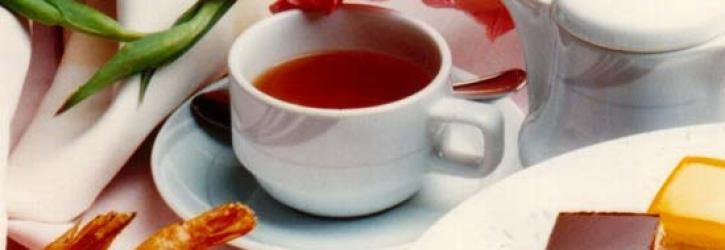A HISTORY LESSON
Legend, and most sources, credit the Chinese Emperor Shen Nung (28th century B.C.) with the discovery of tea. A fastidious man, he always had his drinking water boiled, convinced that this would protect him from the the prevalent diseases of the time.
One day, while making a tour of the provinces, Shen Nung requested that his servants boil some water for him. They made a fire using branches from a nearby camellia bush. Some of the ends of the branches escaped the fire and extended upward. Caught by a passing breeze, a few leaves were released from the branches' hold and floated down into the heating water. The emperor's attention was caught by the aroma which arose from the pot. Intrigued, he drank some of the broth. Immediately captivated by the taste and refreshing quality of the brew, the emperor knew he had discovered something of great importance.
The Chinese were familiar with camellia leaves, which they used in vegetable relishes and quite probably as part of medicinal compounds. But until the emperor's discovery, the leaves had never been considered an ingredient of a hot, refreshing drink. News of the emperor's discovery spread quickly throughout China, and soon everyone was trying the beverage. Before long, tea (known as Ch'a) became an important part of Chinese culture.
As the centuries passed and trade with the West opened up, the status of tea increased. Tea was introduced to continental Europe during Elizabethan times, but did not reach English shores until the years 1657-1660. It was the Dutch who first brought tea to the continent. The Russians also knew about it before the English, as did the Portuguese. And it was a Venetian, Gian Battista Ramusio, who was the first European to write about tea.
When tea was finally introduced to the English populace, it was a very hard sell. Enormously expensive and advertised for its medicinal purposes, tea was very slow to catch on in the British empire. The turning point came when King Charles 2 ascended the throne. King Charles drank tea throughout the day, delighting in the delicate taste and fragrant aroma for which green teas are appreciated. His habit was adopted first by the rest of the court and then by the entire country. Tea was sipped in homes, in taverns, and in pleasure gardens by the aristocracy as well
as their servants.
Tea also enjoyed immense popularity in the American Colonies until the late eighteenth century. But when King George 3 decided to use tea as a source of revenue and raise the import tax on tea sent to the Colonies, the independent-minded Americans rebelled.
The Boston Tea Party of 1773, when colonists dressed as Indians dumped a ship load of tea into Boston Harbor, was one of the events that propelled the Colonies toward independence, and probably led to a marked preference for coffee in the United States.
Afternoon tea was invented by Anna, the seventh Duchess of Bedford (1783-1857), one of Queen Victoria's ladies-in-waiting. In her day, the upper crust ate a huge breakfast, little lunch, and a very late dinner. Every afternoon, the duchess experienced a "sinking feeling." One afternoon she instructed her servants to serve tea and little cakes in her boudoir. The experience was so delightful that Anna repeated it every afternoon thereafter.
Soon others followed the Duchess' lead, and in just a few decades the custom of "taking tea" in the afternoon had become well established. At first the practice was limited to the upper classes, but it eventually became so popular that tea shops and tea-rooms began opening for the enjoyment of the general public.
America's Part in the History of Tea The United States can claim two distinct contributions when it comes to tea, both dating from the early twentieth century.
In 1904, visitors to the Louisiana Purchase Exposition in St. Louis sweltered in a heat wave and shunned the hot brew offered by Indian tea growers. An Englishman named Richard Blechynden, who represented the tea growers, tried pouring tea over ice in order to entice fair visitors. The result was iced tea, which now accounts for 80 percent of the tea drunk in the United States.
The teabag began as the brainstorm of an American tea merchant named Thomas Sullivan, who hit on the idea of providing samples to his customers in small silk pouches. Sullivan's customers soon discovered that the pouches could be put directly (and conveniently) in teapots, and soon orders were pouring in for tea packaged in "those little bags". Before long, teabags had become a widely accepted means of packaging tea.

